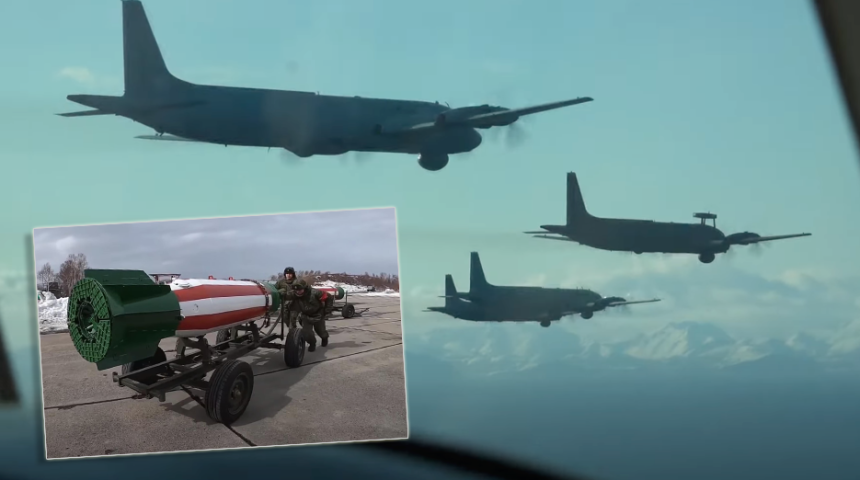For the first time, five Russian Navy Il-38 and Il-38N aircraft have taken part together in an Anti-Submarine Warfare exercise laying sea bottom mines.
Russian Navy Il-38 and Il-38N “Dolphin” (NATO reporting name “May”) Anti-Submarine Warfare and Maritime Patrol Aircraft have recently taken part in an ASW exercise held in the Avacha Bay, a Pacific Ocean bay on the southeastern coast of the Kamchatka Peninsula, in Russia’s Far East.
According to the Russian Ministry of Defense, as part of the final check of the winter training period, the Russian Navy aircrews carried out a mission whose purpose was to search, detect and track enemy submarines. And, for the first time, during that mission five Il-38s of the Pacific Fleet conducted a group operation, which saw the ASW aircraft lay air-dropped mines to create a barrier against notional enemy subs.
About 50 training mines of various types were dropped during the simulated attack to the simulated underwater target.
Interestingly, the footage released by the Russian MOD shows some of those mines.
The Il-38N or Il-38SD is the improved variant of the baseline Il-38 aircraft. The main difference between the Il-38 (largely based on the original Il-18 airliner) and Il-38N is that the latter is equipped with the Leninets Novella-P-39 and Sea Dragon systems which, according to “Russia’s Warplanes Vol. 2” by Piotr Butowski, integrate several sensors, including a radar for detecting aerial and surface targets; radio sonobuoy system; a MAD (Magnetic Anomaly Detector) with a range up to 900m; an EO (Electro-Optical) turret with TV, IR, imaging, laser rangefinder and automatica target tracking; ESM (Electronic Support Measures) with sensors hosted in a circular pattern in a box fairing located over the forward section of the fuselage.
Russia’s Naval Aviation has a huge inventory of air-dropped mines. Since these have a long service life, a number of really old types remain in the inventory. Based on their size and explosive charge, mines can be subdivided into superlarge (UDM-2, DM-1, MDM-5, MDM-1, MDM-6), large (IGDM, AMD-2M, Serpei, UDM, MDM-4) and small (IGDM-500, UDM-500, MDM-3). Among them, mines of the AMD series (Aviationnaya Mina Donnaya, Russian for “aerial bottom mine”) have been developed since WWII. The modernized AMD-2M (500kg and 1000 kg) are among those currently used by the Russian Navy ASW aircraft. The family of UDM (Universalnaya Donnaya Mina – “universal bottom mine”), designated MDM for export, are more recent and have been developed since 1961. The latest is the UDM-2-1500. The large one you can see at the beginning of the clip, appears to be a UDM-2 mine.
The Il-38 carries 8x AMD-2-500M or 4x UDM mines in the two bays in the fuselage, one forward and one aft of the wing’s spar, in the mine-laying role.
Some interesting details about the UDM-2 mine are available through the Rosoboronexport (the state intermediary agency for Russia’s exports/imports of weapons, technologies and services ) website. In the MDM-2 (the export version of the UDM-2) section we can find the following:
MDM-1 mod.1 and MDM-2 mod.1 sea bottom mines are intended for employment in minefields to endanger and destroy ships and surfaced or submerged submarines. MDM-3-mod.1 sea bottom mine is used in defensive minefields to destroy small displacement ships and amphibious assault craft.
The mines are fitted with local three-channel influence exploders activated by target’s acoustic, electromagnetic and hydrodynamic fields sensed in a hemispherical danger zone. The exploders allow the mines to be deployed in both three- and two-channel configurations, with any combination of the channels possible. The mines possess effective anti-sweeping protection from modern influence sweepers and resistance to natural clutter owing to advanced exploder operating principle and anti-sweep device logic, as well as mine timing and ship counting devices employed. Intricate planting patterns and camouflage painting of the mines hinder their detection by sonars of surface ships and submarines, or by mine-hunting devices of remotely operated underwater vehicles.
The mine can be planted from aircraft (airborne platforms) fitted with mine racks and safety actuation and release devices, as well as from surface ships equipped with mine-laying rails and ramps or mine-scattering systems. Mines can be laid by ships sailing at speeds of up to 15 knots, and by aircraft flying at speeds of up to 1,000 km/h from altitudes of not less than 500 m.
The mine is self-destroyed when its service life expires, or if planted on land or shoal from aircraft.”
While the first mine you can see in the video as it is loaded into the Il-38 appears to be a superlarge UDM-2, the one that you can find later in the same clip at the 00:40 mark is a smaller UDM-3.









